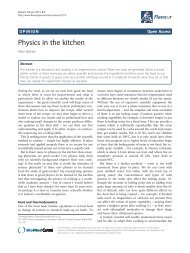(Coriandrum sativum) disliking among different ... - Flavour
(Coriandrum sativum) disliking among different ... - Flavour
(Coriandrum sativum) disliking among different ... - Flavour
You also want an ePaper? Increase the reach of your titles
YUMPU automatically turns print PDFs into web optimized ePapers that Google loves.
Mauer and El-Sohemy <strong>Flavour</strong> 2012, 1:8 Page 4 of 5<br />
http://www.flavourjournal.com/content/1/1/8<br />
Table 3 Leaf lettuce preference distributions between <strong>different</strong> ethnocultural groups<br />
Preference category a<br />
Have tried b<br />
Have not tried c<br />
Like Neutral Dislike Never tried Would not try<br />
Caucasian (n = 581) 518 (89) 50 (9) 11 (2) 2 (0.3) 0<br />
East Asian (n = 540) 441 (82) 78 (15) 17 (3) 4 (0.7) 0<br />
South Asian (n = 165) 133 (84) 22 (14) 3 (2) 7 (4.2) 0<br />
Middle Eastern (n = 36) 36 (100) 0 0 0 0<br />
Hispanic (n = 27) 26 (96) 0 1 (4) 0 0<br />
African Descent (n = 32) 23 (74) 6 (19) 2 (6) 1 (3) 0<br />
a Subjects selecting 1 to 4 are classified as dislikers, 5areneutral, 6 to 9 are likers;<br />
b Values are n(%) of subjects who have tried leaf lettuce.<br />
c Values are n(%) of ethnocultural group.<br />
dislike cilantro are anosmic to one or more of the pleasant<br />
smelling compounds found in cilantro. Alternatively, those<br />
who like cilantro may be anosmic to an unpleasant smelling<br />
compound - perhaps an aldehyde that, alone, smells of<br />
soap [3]. E-(2)-Decenal has been proposed as a candidate<br />
compound, as it is emitted by stink bugs and other insects<br />
in defensive secretions [24,25]. It has been suggested that<br />
this may be one of the compounds in cilantro that individuals<br />
find unpleasant, although this has not yet been tested.<br />
Because of the complex chemical composition of the oil of<br />
cilantro leaves, there are many potential candidates. Considering<br />
there are approximately 350 olfactory receptor<br />
genes and another 300 or more olfactory receptor pseudogenes<br />
of unknown function [17,26], there are many potential<br />
candidates that could explain inter-individual<br />
differences in cilantro preference. The interaction between<br />
taste and olfaction is well-established [27], but it remains<br />
unclear whether one is more influential than the other with<br />
respect to cilantro preference.<br />
Although differences in flavor perception, possibly attributable<br />
to genetic differences between ethnocultural<br />
groups, is likely responsible for the <strong>different</strong> distributions<br />
of cilantro preference seen, we cannot rule out the possibility<br />
of differences in exposure and use of cilantro in the<br />
traditional cuisines of <strong>different</strong> ethnocultural groups<br />
driving differences in preference. The relationship between<br />
flavor perception, familiarity and exposure, and<br />
preference is complex and cannot be further explored in<br />
the present study. Future studies will need to be conducted<br />
to determine the cause of the <strong>different</strong> preference<br />
distributions observed in this study.<br />
It should be noted that the current study consists of a<br />
convenience sample of young adults recruited from the<br />
University of Toronto campus and results may not reflect<br />
older adults or the Canadian population in general.<br />
Further studies will be required to assess the prevalence<br />
of cilantro liking and <strong>disliking</strong> in the broader population<br />
and <strong>among</strong> other ethnocultural groups.<br />
Conclusions<br />
In summary, we report that cilantro dislike varies from 3%<br />
to 21% in this population of young adults depending on<br />
the ethnocultural group. The contribution of individual<br />
genetic differences to this trait remains to be determined.<br />
Methods<br />
Subjects<br />
Participants (n = 1,639; 1,117 women and 522 men) were<br />
enrolled in the Toronto Nutrigenomics and Health Study,<br />
which is a cross-sectional study investigating gene-diet<br />
interactions and biomarkers of chronic disease, as well as<br />
genetic determinants of eating behaviors. Subjects between<br />
20 and 29 years of age were recruited from the University<br />
of Toronto campus. Subjects were excluded if they were<br />
pregnant or breastfeeding, due to metabolic and dietary<br />
changes that take place during this period. Subjects who<br />
could not communicate in English, or who did not provide<br />
a 12-hour fasting venous blood sample were also excluded.<br />
Smokers (n = 105) were excluded from the present analysis<br />
because of the known effects of smoking on taste and odor<br />
perception [17]. Subjects with any missing data were also<br />
excluded (n = 10). At the time of screening, subjects identified<br />
the ethnocultural group(s) they belong to. Subjects who<br />
listed more than one ethnicity (n = 143) or any group with<br />
fewer than 20 subjects were excluded from the current analyses,<br />
and the remaining individuals were classified into one<br />
of six groups (Caucasian, n = 581; East Asian, n = 540;<br />
South Asian, n = 165; Middle Eastern, n = 36; African<br />
descent, n = 32; and Hispanic, n = 27). After exclusions,<br />
the final sample population consisted of 1,381 subjects<br />
(962 women and 419 men). All subjects provided written<br />
informed consent, and the University of Toronto Research<br />
Ethics Board approved the study protocol.<br />
Cilantro preference data collection<br />
Subjects completed a 63-item food preference checklist,<br />
which included a range of common foods and beverages,




